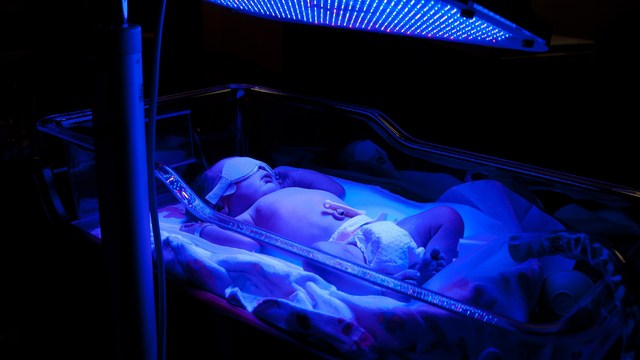I remember vividly, with all the emotion and awe that I had then, all the gratitude, wonder and exhaustion that accompanied it, the day when my second son was born. It was a beautiful, easy and fast delivery, two days after the Twin Towers went down, I'd been shaken and shocked and was now ready, not wanting to be pregnant and watching the news, but to be holding my boy safely in my arms. Gabe was born without any sort of medical intervention or assistance. I gave birth naturally and he was a healthy, fiesty newborn. He slept. He nursed. He eliminated like a champ. And then, in the second week of his life, he suddenly turned yellow and looked like he wasn't supposed to look; the rosiness disappeared, my panic began to set in.
The doctor said he had "jaundice" and that I should hold him under sunlight for as many moments as possible during the day. Living in Los Angeles made this easy; having a two and a half year old wanting to play did not. But over the course of a few days, sunlight included religiously in our daily routine, my baby's color slowly returned and the yellowness faded into the nether regions of my memory.
What is jaundice, really?
Jaundice itself is not a disease. It is a condition that can occur and is an indicator of another condition or disease, mostly related to liver function. The appearance of yellowish skin and yellow to brownish whites of the eyes is indicative of jaundice and may mean that the liver is not functioning properly. More specifically, it means that there are high levels of a chemical called "bilirubin" in the bloodstream and this in and of itself is causing the yellowing.
Bilirubin is actually a chemical that forms in the red blood cells if iron is taken out or limited, as in the case of anemia.
Bilirubin is considered a waste product and something that the liver works to eliminate. If there is an overabundance of bilirubin the bloodstream, or if there is a problem with the liver, an elevated bilirubin level can lead to jaundice.
In newborns, as with my son, sometimes the slow development of the liver can lead to bilibrubin elevation and subsequent jaundice. In rarer cases, an incompatible blood type between mother and newborn can cause breastfeeding to actually damage red blood cells in the infant, thus leading to dangerously high levels of bilirubin.
Phototherapy, which is what helped my son, is often recommended, as is an increase in breastmilk or formula to help pass the bilirubin through the system more quickly. In cases of blood-related issues a mother may be injected with a certain type of blood to prevent incompatibility and the baby may be given a blood transfusion.
For more on jaundice in infants see the following link:
http://kidshealth.org/parent/pregnancy_newborn/common/jaundice.html#
http://www.medicinenet.com/jaundice/article.htm
Aimee Boyle lives in CT with her two boys, growing up so quickly. She is a regular contributor to EmpowHer.




Add a CommentComments
There are no comments yet. Be the first one and get the conversation started!